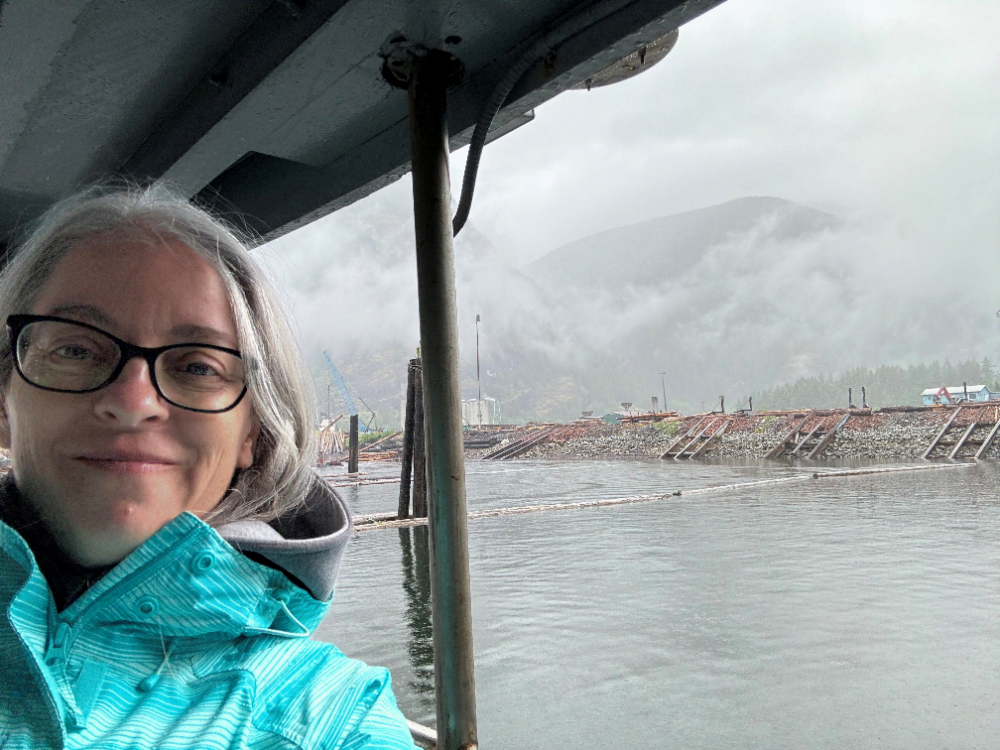Commemorating Residential School Sites, Their History and Legacy
*Trigger warning – This text relates to Indian Residential Schools. The Residential School System is a topic that may cause trauma invoked by memories of past abuse. A National Residential School Crisis Line has been set up to provide support for former residential school students and their families. You can access information on the website or access emotional and crisis referral services by calling the 24-Hour National Crisis Line: 1-866-925-4419.
In 2020, the Government of Canada designated the Residential School System a national historic event under the National Program of Historical Commemoration, administered by Parks Canada. The Federal Government also designated the former Portage La Prairie Indian Residential School (Manitoba) and the former Shubenacadie Indian Residential School (Nova Scotia) as national historic sites. A year later, the former Shingwauk Indian Residential School (Ontario) and the former Muscowequan Indian Residential School (Saskatchewan) were likewise designated as national historic sites.
Recognizing the national historic significance of the residential school system of these sites was one of the goals set forth by the Survivors, Indigenous organizations, and communities who played a key role in initiating the process of heritage designation. These groups nominated the residential school system and the former residential school sites for consideration by the Historic Sites and Monuments Board of Canada (the Board), which makes recommendations for designation to the Honourable Steven Guilbeault, Minister of Environment and Climate Change and Minister responsible for Parks Canada. For each of these subjects, Parks Canada historians worked collaboratively with Survivors to tell their stories and to determine the significance of the event and former school sites. As Chief Reginald Bellerose of Muskowekwan First Nation explained, Survivors and community members, “worked diligently with Parks Canada to ensure Muscowequan Indian Residential School received its designation as a national historic site because our history in these schools need to be acknowledged, recognized and on display for all Canadians to learn about.”[1] For Chief Dennis Meeches of the Long Plain First Nation, the national historic recognition of residential schools was the result of, “many years of hard work” that saw “Survivors and community members [join] in the effort to preserve the building and their stories because this is also a story of resilience and a long journey towards healing.”[2]
While the early history of residential schooling dates back to New France and the British colonial period of Canadian history, following Confederation in 1867, these schools were largely operated by Christian churches and religious organizations and administered and funded by the federal government. In the late 19th century, the residential school system was gradually expanded and imposed on Indigenous Peoples as part of a broad set of assimilation efforts to destroy their rich cultures and identities and to suppress their histories. With the last school closing in 1997, the Residential School System has impacted multiple generations of Indigenous Peoples, with long-term detrimental effects on First Nations, Inuit, and Métis communities, cultures, economies, traditional knowledge and ways of life, languages, family structures, and connections to the land.
Three of the four former residential schools that have been designated as national historic sites are among the few surviving residential school sites with preserved built elements. The former school at Shubenacadie no longer exists, and yet as the only school built in the Maritimes, it “stands as a testament to the impact of the experiences of […] Survivors, their families and communities, and will preserve a part of Canadian history that should never be forgotten.”[3] Tim Bernard, Executive Director, Mi’kmawey Debert Cultural Centre and Co-chair of the Tripartite Culture and Heritage Working Committee who nominated the residential school site on behalf of Survivors, explains that, “[a]lthough the building is no longer standing, our Survivors have prioritized a National Historic Site designation, and we, as a community, will have the opportunity to continue our journey of healing.”[4]
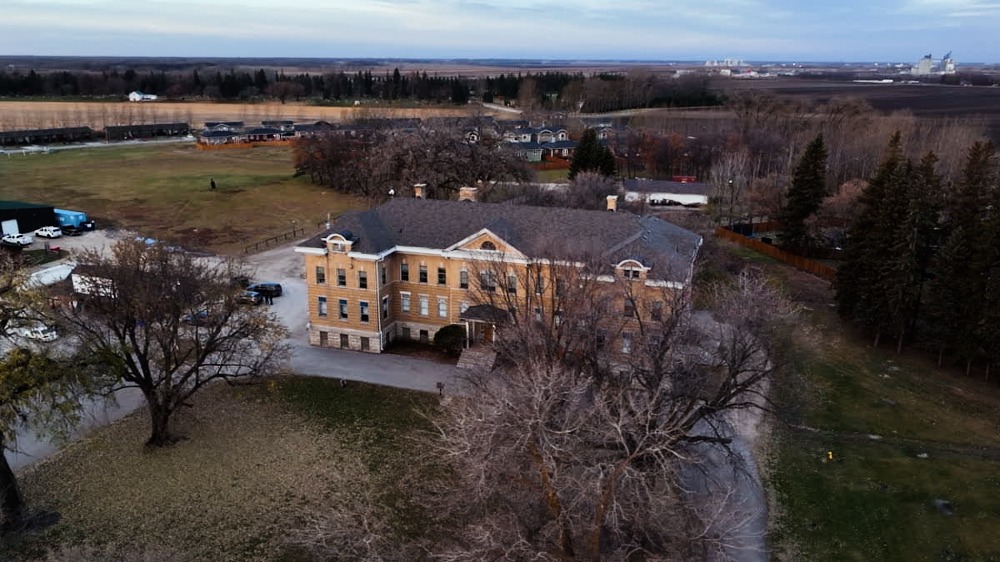
Aerial view of the Former Portage La Prairie Indian Residential School National Historic Site, 2023, Parks Canada.
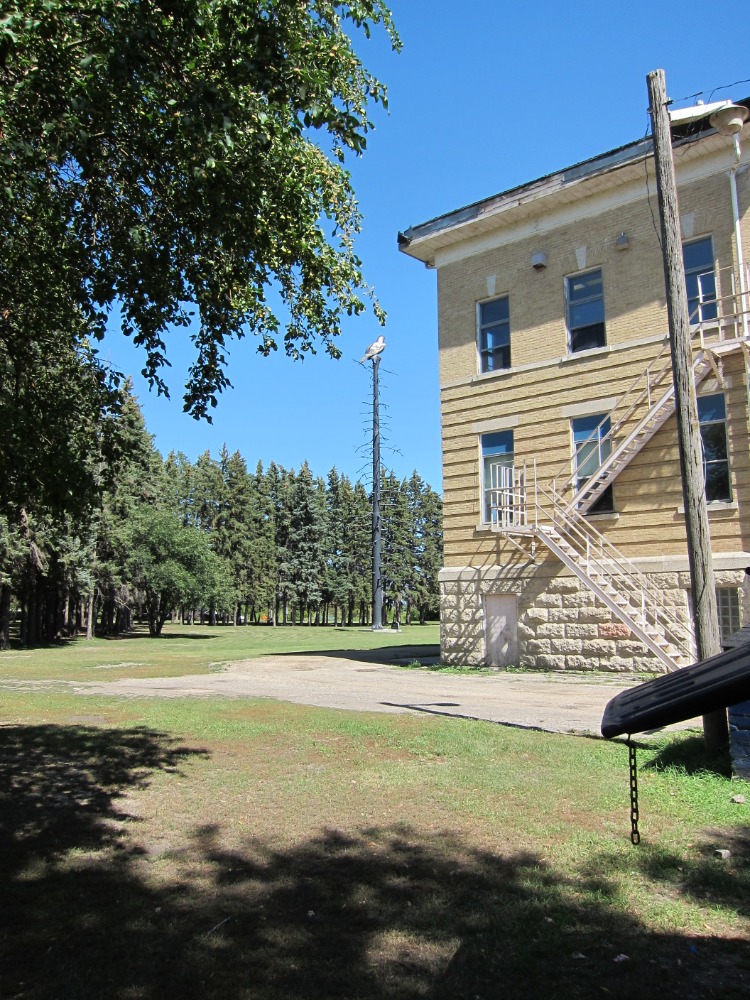
Eagle sculpture located on the north side of the former Portage La Prairie residential school building, 2019 (Allison Sarkar, Parks Canada).
Children who were sent to the Portage La Prairie residential school came from many First Nations and other Indigenous communities within Manitoba and elsewhere. Built in 1914-15, the former school is a large, three-storey brick building located on the reserve lands of Long Plain First Nation in Manitoba. The building has a substantial presence and is set back from a relatively quiet road and surrounded by mature trees and an expansive lawn. A dramatic sculpture of an eagle is adjacent to the site. The school closed in 1975 and six years later, the building and its surrounding lands were transferred to Long Plain First Nation to fulfill part of their treaty land entitlement. The school has been readapted by the First Nation to serve a number of community purposes, and has been given new meaning by the community as a site of commemoration and as a museum dedicated to residential school history to keep the legacy of the residential school era alive and educate the public. This former residential school is located on the reserve land of Long Plain First Nation, the traditional land of the Anishinaabe and the Métis.
Former Muscowequan Indian Residential School National Historic Site
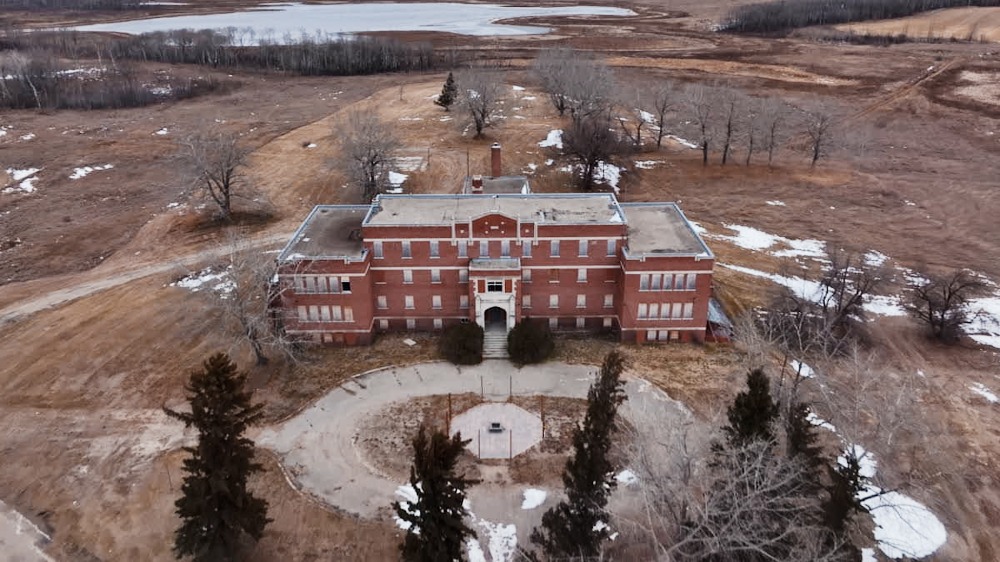
Aerial view of the Former Muscowequan Indian Residential School National Historic Site, 2023, Parks Canada.
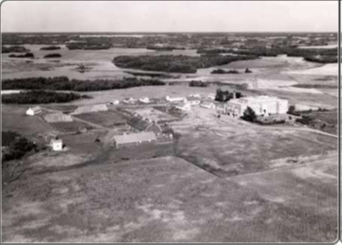
Aerial view of the Muscowequan residential school site, showing the location of barns, fields, and outbuildings, no date. (Archives de la Société historique de Saint-Boniface, Fonds Oblats de Marie- Immaculée Province du Manitoba/Délégation, SHSB28789) (used with permission)
Children from many First Nations and other Indigenous communities in Treaty 4 Territory, across Saskatchewan, and elsewhere in Canada attended Muscowequan residential school. This imposing, three-storey former school building was built in 1930-31 to replace residential school buildings dating to the late-19th century. It was once part of a large school property that included a working farm, outbuildings, playgrounds, and skating rinks. The residential school remained open until 1997. The school building has been saved from demolition by Muscowequan Survivors and community members who see it as an important witness to the history of residential schools and wish to repurpose the site into a place of commemoration, healing, cultural learning, and as a site of memory for all Canadians. The former residential school is on Treaty 4 Territory, the original lands of the nêhiyaw/Cree, Nahkawe/Saulteaux, Dakota, Lakota, Nakota, and the Michif/Métis Nations.
Former Shingwauk Indian Residential School National Historic Site
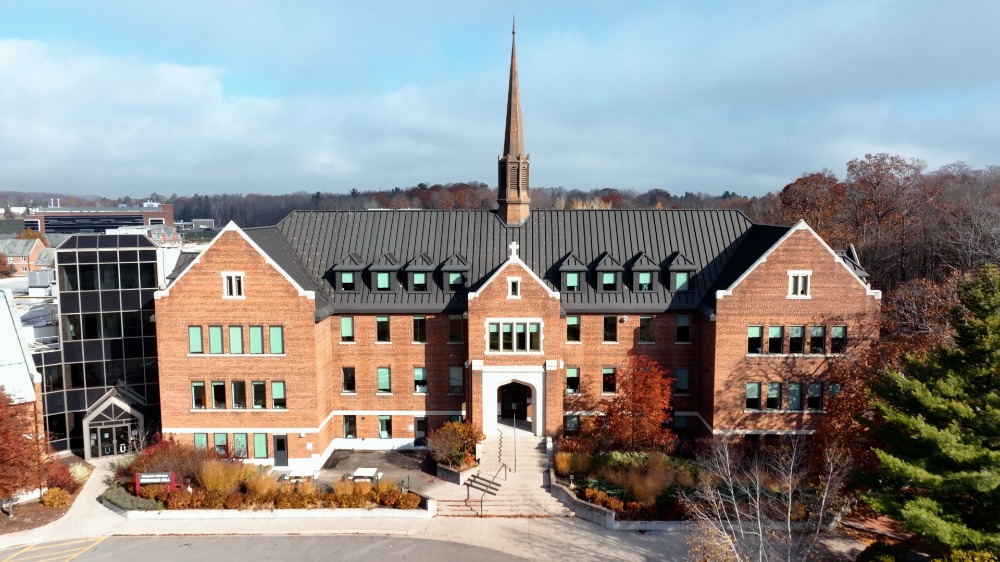
Former Shingwauk Indian Residential School National Historic Site, 2023, Parks Canada
Indigenous children from Ontario, Quebec, the Prairies, and the Northwest Territories attended Shingwauk residential school. Shingwauk Hall, the school’s primary structure, was built in 1934-35 to replace the original school building which dated to the late-19th century. Other buildings and landscape elements related to the former school that remain on the site include the Shingwauk Memorial Cemetery (1876), Bishop Fauquier Memorial Chapel (1883), the former principal’s residence (1935), the former woodworking shop (1951), and Anna McCrea Public School (1956). Since the closure of the school in 1970, the site has been a place of cultural reclamation and education. The Children of Shingwauk Alumni Association and their partners have been committed to the restoration of the true intent and spirit of Chief Shingwaukonse’s vision – cross-cultural education and learning – and the reinterpretation of the site as a place for healing and reconciliation. The former school property encompasses the present campus of Algoma University and Shingwauk Kinoomaage Gamig (Shingwauk University). In Shingwauk Hall, a permanent exhibit on residential school history was installed. The former residential school is on Robinson-Huron treaty territory, the traditional homeland of the Anishinaabe and the Métis.
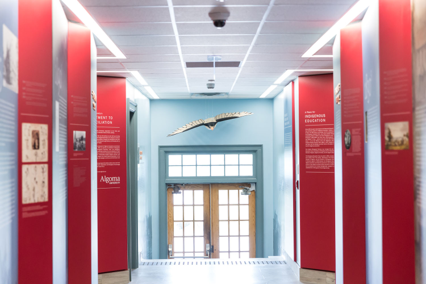
Interior view of the main entrance doors with exhibit panels for Reclaiming
Shingwauk, Algoma University.
Former Shubenacadie Residential School National Historic Site
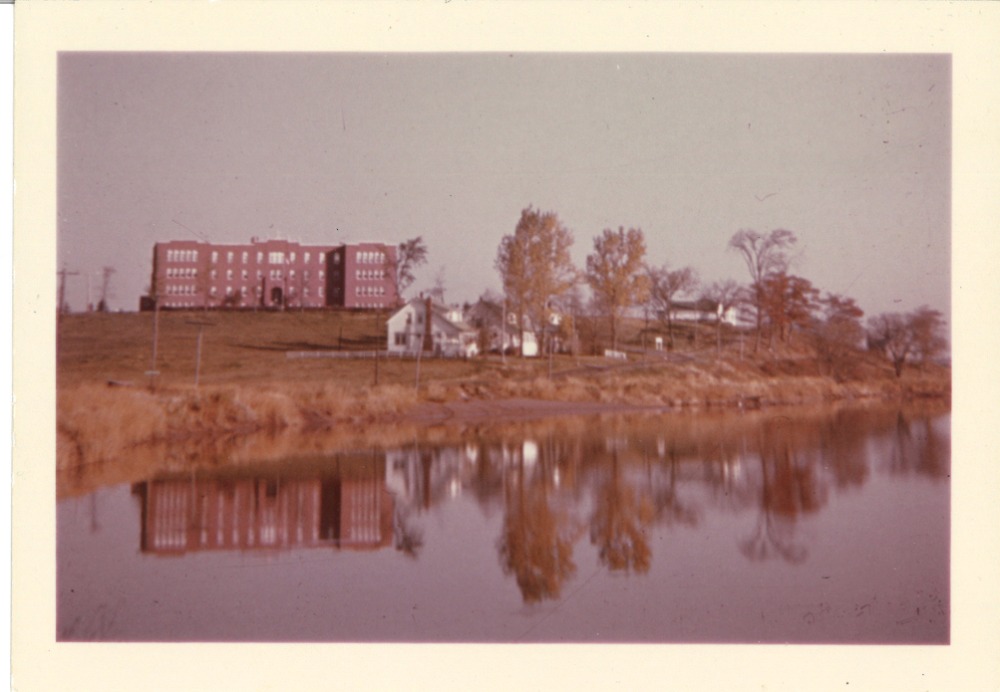
Shubenacadie Residential School main school building overlooking the Shubenacadie River, showing staff housing (front) and workshop and root cellar (right). Date unknown. Sisters of Charity Halifax, Congregational Archives (used with permission).
Mi’kmaq and Wolastoqiyik children from Nova Scotia, Prince Edward Island, New Brunswick, and Quebec attended Shubenacadie residential school. The only Indian Residential School in the Maritime Provinces, this school was established in 1929 and was open to students from 1930 to 1967. The school building once stood on a large property that featured barns and other farm buildings, staff residences, cultivated fields, and pastures. The abandoned school building was demolished in 1986 and a factory now stands in its place. Although the school building is no longer standing, the site of the former school is a place of remembrance and healing for some survivors and their descendants, who wish to preserve Indian Residential School history in the Maritimes. The residential school was located in the Sipekne’katik district of Mi’kma’ki, the ancestral and unceded territory of the Mi’kmaq.
These designations help communicate to Canada and the world the enduring impact that residential schools have had on Indigenous communities. Three of the four residential school designations will be commemorated by the installation of HSMBC bronze plaques while the fourth will be commemorated by an alternative form of commemoration, to be determined by Survivors. The HSMBC plaques have been installed at the Former Shubenacadie Indian Residential School National Historic Site and plans are underway to prepare the plaques for Portage la Prairie Indian Residential School National Historic Site and Muscowequan Indian Residential School National Historic Site.
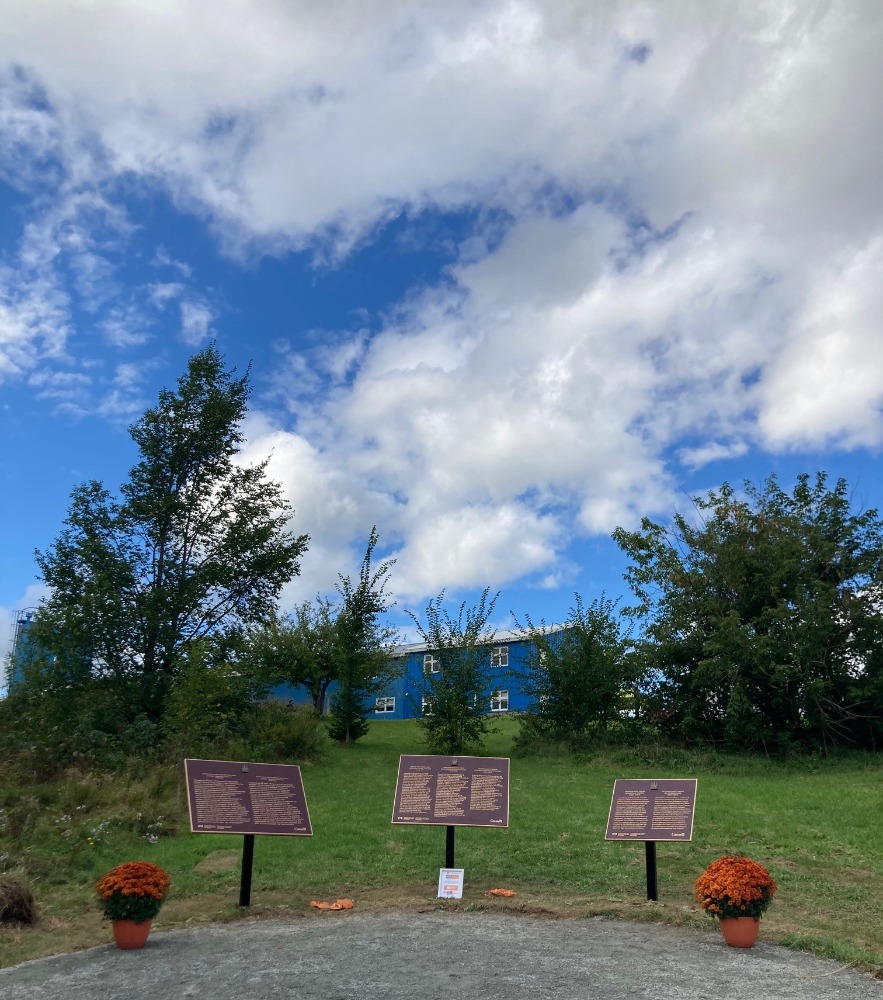
Historic Sites and Monuments Board of Canada commemorative plaques at the former Shubenacadie Indian Residential School National Historic Site. The blue building in the background is a factory that is located on part of the footprint of the main residential school building, Shubenacadie, Nova Scotia Parks Canada, 2021.
On September 30, 2021, the first National Day of Truth and Reconciliation, Survivors and their families gathered at the site of the former Shubenacadie Indian Residential School National Historic Site for the commemoration ceremony. Survivors were involved in developing the text of the commemorative plaque. Three plaques with texts in Mi’kmaq, Wolastoqey, English, and French were installed on the site of the former school. For Shubenacadie IRS Survivor and Elder Dorene Bernard, these commemorative plaques tell, “the story about why residential schools were built, the impacts of the residential school on our people and who we are. This site honours that memory. This site or this place says we’re still here.” [5] The “Mikwite’tmek, We Remember: Shubenacadie Indian Residential School” is a video produced through a collaboration between Mi’kmawey Debert Cultural Centre and Parks Canada, Survivors and descendants, which shares personal experiences of the many ways the Shubenacadie residential school sought to take away language, culture, and ways of life. (Link to video: https://youtu.be/T5176YRvcVA?feature=shared). There is work underway to produce commemorative videos for each of the four designated residential school sites in collaboration with Survivors of each of those schools.
These designations are an important part of the Government of Canada’s response to Call to Action 79 of the Final Report of the Truth and Reconciliation Commission, which called for national commemoration of residential school sites and the history and legacy of residential schools. Parks Canada, with Survivors, and communities who are ready to do so, is committed to raising awareness of the experiences of the children who attended these schools to ensure that this history is acknowledged and better understood by all Canadians. These are but one small piece of the work that Survivors and communities are doing to keep alive the legacy of what these residential school system and sites mean.
[1] Chief Reginald Bellerose, Muskowekwan First Nation, https://www.canada.ca/en/parks-canada/news/2021/07/government-of-canada-recognizes-the-national-historic-significance-of-former-muscowequan-indian-residential-school.html
[2] Chief Chief Dennis Meeches, Long Plain First Nation, https://www.canada.ca/en/parks-canada/news/2020/09/government-of-canada-recognizes-the-national-historic-significance-of-the-residential-school-system-and-former-residential-school-sites.html
[3] Tim Bernard, Executive Director, Mi’kmawey Debert, Confederacy of Mainland Mi’kmaq, https://www.canada.ca/en/parks-canada/news/2020/09/government-of-canada-recognizes-the-national-historic-significance-of-the-residential-school-system-and-former-residential-school-sites.html
[4] Tim Bernard, Executive Director, Mi’kmawey Debert, Confederacy of Mainland Mi’kmaq, https://www.canada.ca/en/parks-canada/news/2020/09/government-of-canada-recognizes-the-national-historic-significance-of-the-residential-school-system-and-former-residential-school-sites.html
[5] “Mikwite’tmek, We remember: Shubenacadie Indian Residential School,” Mi’kmawey Debert Cultural Centre and Parks Canada, 2024, https://www.youtube.com/watch?v=T5176YRvcVA.

